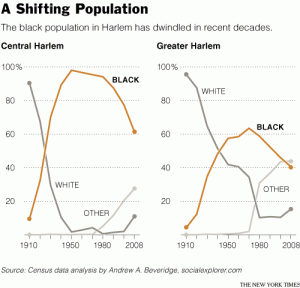[youtube]http://www.youtube.com/watch?v=twkMmda3qss[/youtube]
Sources: http://ccgsapp.org/notes/2011/06/harlem-fading-black-mecca; http://www.youtube.com/watch?v=T3UEk3wP2Hs; http://www.youtube.com/watch?v=xdF1EEVhNqY
For almost a century, Harlem has been synonymous with black urban America. The historic residential enclaves and a number of cultural institutions along with growing number of incoming younger black professionals, the neighborhood’s reputation as the capital of black America seems unlikely to change anytime soon.
The neighborhood, however, is undergoing a profound and accelerating shift. In greater Harlem, which runs river to river, and from East 96th Street and West 106th Street to West 155th Street, blacks are no longer a majority of the population which actually occurred a decade ago, but was largely unnoticed.
In 1910, black population was about 10 percent of Harlem’s total population. The number of blacks living in greater Harlem hit a high of 341,000 in 1950, and their share of the population peaked in 1970, when they made up about 64 percent of the residents. In the late 2000s, there were around 153,000 blacks in greater Harlem, and they made up 41 percent of the population, down from earlier figure.
Lance Freeman, a professor of urban planning department in Columbia University and the author of “There goes the hood” talked about his view on Harlem’s gentrification.
There are mixed views on gentrification. Some of the residents see it as cleansing the sleek and dark image of drug dealing and crimes by bringing in more middle-income people and retail shops targeting them. One of the recent representation of these phenomena is the new opening of “Red Rooster” in Harlem by Marcus Samuellson.
At the same time, it is elevating the price and rents of the community and effectively shoving off local residents who can no longer afford the price. In late 2000s, the average price for new condominium apartments in Harlem hit $900,000, although average household income remains less than $25,000.
Source: www.propertyshark.com
Purple shows where real estate prices are relatively high compared to the median income of the block — i.e. where rich people are moving in.
“There are people who would like to maintain Harlem as a ‘black enclave,’ but the only way to do that is to own it,” said Mr. Dodson, who is the director of the Schomburg Center for Research in Black Culture. “That being said, you can’t have it both ways: You can’t on the one hand say you oppose being discriminated against by others who prevent you from living where you want to, and say out of the other side of your mouth that nobody but black people can live in Harlem.” The question of whether it’s a good thing or not, he can’t make that judgment yet.
Maybe we don’t even need to make any judgment. Maybe a place like Paris Blues Café, a local jazz and blues dive bar at 121 and Lenox, owned by a third generation of French and Italian working with a latino black woman fluent in five different languages, would tell us how Harlem would manifest itself in the coming future.[youtube]http://www.youtube.com/watch?v=Ukorx4I-kG0[/youtube]
Text reference: No Longer Majority Black, Harlem Is in Transition

